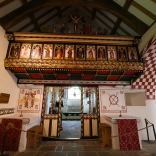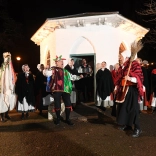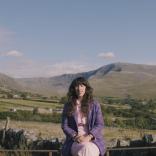A colourful – often turbulent – history, along with a penchant for the mythical, means Wales has adopted a weird and wonderful array of objects and concepts into its cultural identity; things that today serve as emblems of the country.
Here’s a lowdown on a few of them, with info on how and why they’ve managed to become synonymous with modern-day Wales.
Y Ddraig Goch (the red dragon)
Nothing sends Welsh hearts aflutter like the sight of the mighty red dragon. The centrepiece of the Welsh national flag, the ddraig goch personifies the fearlessness of the Welsh nation.
According to legends first referenced in the Mabinogion (the earliest collection of British prose), the red dragon of Wales is locked in an era-spanning battle with an invading white dragon (which has come to symbolise England) – a battle it ultimately wins; ensuring its lasting appeal as a sign of Welsh pride. Having been used in various forms as an insignia by Welsh armies throughout history, it became the focus of the Welsh national flag in 1959.


The daffodil
Instantly recognisable thanks to its bright yellow petals, the daffodil is considered the national flower of Wales.
Exactly how the flower wangled its way into Welsh culture (with links between the two only really forming in the 19th century) is something of a mystery, but its rise in status was likely aided by the flower’s Welsh name: cenhinen Bedr, which literally translates as ‘Peter’s leek’ – leeks having been a symbol of Wales since before the 16th century (though, who exactly Peter is, we’re not sure) – and the way they tend to come into bloom around St David’s Day (Wales’ national day) on 1 March. The fact they’re also somewhat prettier than leeks (especially when worn on clothing), likely aided their swift rise to fame as emblems of Wales.

The leek
Before there was the daffodil, there was the humble leek. This root vegetable is so well established as part of Welsh culture that wearing a leek to signify you come from Wales is noted as an ‘ancient tradition’ in William Shakespeare’s Henry V, first performed in the 16th century.
But why wear a leek? Legends claim that the 7th century king of Gwynedd, Cadwaladr, ordered his men to strap a leek to their armour to help easily distinguish them from the enemy in the heat of battle, a tale that perhaps inspired the Tudor royal household (who were of Welsh origin) to instruct their guards to wear leeks on St David’s Day, cementing the practice. Whatever the origins, we grow plenty of them and they taste lovely – especially in a Welsh cawl.

The Welsh language
Whether it be a cordial bore da (‘good morning’) in a shop or a hair-raising rendition of the national anthem ‘Hen Wlad Fy Nhadau’ (‘Land of my Fathers’) at a rugby or football match, the Welsh language is a cornerstone of Welsh identity and is spoken by three-quarters of a million people – most in Wales, but also in England, the USA, Canada and Patagonia (a country with which Wales shares much history: The links between Wales and Patagonia).
Welsh is growing in popularity throughout the country, and no visitor will leave without getting a taste of this unique dialect, if not hearing it in the streets, on TV or radio, then seeing it written on the country’s signs and road markings – Croeso i Gymru (welcome to Wales).
Find out more about the Welsh language from our national poet, Ifor ap Glyn.
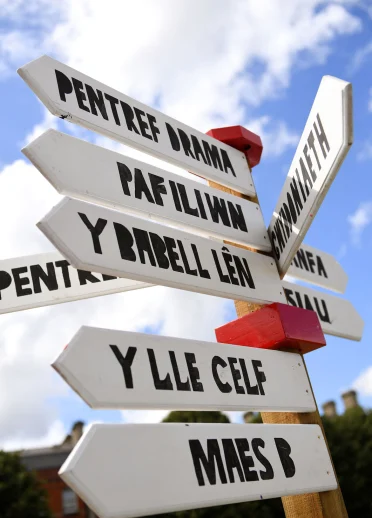

Welsh lovespoons
While eating utensils might not be the first thing that spring to mind when it comes to romantic gift ideas, in Wales intricately carved wooden spoons have been given as a token of endearment for centuries. Young men, typically with little money and a fair bit of free time, took to carving beautiful designs (such as hearts, bells or locks) into humble wooden spoons. This taxing discipline demonstrated the profundity of their feelings to their beloved, and their crafting abilities to their potential suitor’s family.
The oldest existing lovespoon in Wales dates back to 1667 and can be seen at the wonderful St Fagans National Museum of History, but still remain a popular present for loved ones today.

Male voice choirs
It could be a result of cultural festivals like the Eisteddfod (the largest festival of competitive poetry and music in Europe, which has been running since 1176), circumstance (notably the rise of the mining industry, which brought together large groups of men who enjoyed singing without instruments as a free social activity), or even the lyrical nature of the Welsh language, but, for whatever reason, Wales loves the mellifluous tones of a male voice choir.
You’ll likely hear choirs during large celebrations and sporting spectacles (notably international rugby matches) as well as – less polished – performances in local pubs and rugby clubs. Traditional bedrocks of the movement include Treorchy choir and Morriston choir, while the more recent success of Only Men Aloud has ensured that the male voice choir tradition remains as popular as ever.
The red kite
Though once a common sight across the United Kingdom, red kites were hunted to the point where, in the 1980s, only a handful survived, hidden away in the remote valleys of mid-Wales. Thanks to – frankly miraculous – conservation efforts during the following decades, however, these beautiful birds of prey can once again be seen soaring over rural areas of Wales, and in 2007 the Welsh people voted the copper-breasted raptor as the nation’s favourite bird.
Several red kite feeding stations around the country offer visitors the opportunity to sight these majestic creatures, which also feature on the branding of a number of Welsh businesses and organisations, including Powys County Council. Find out more about getting up close with the red kites on Visit Wales.
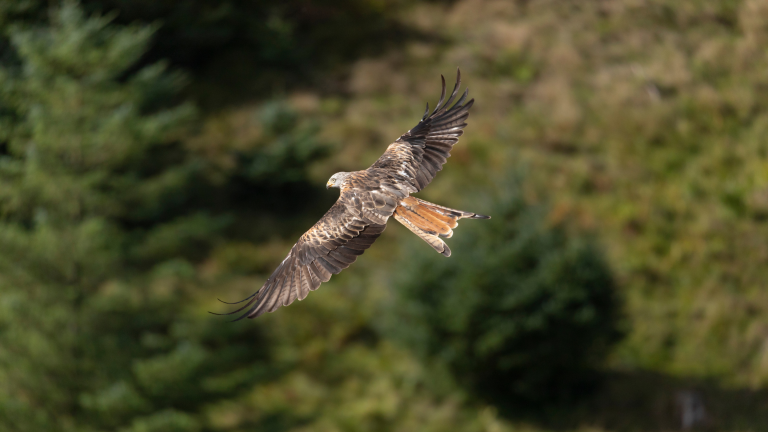
The Welsh harp
From ice cream to opera, there are many famous Italian inventions that have been warmly welcomed into Welsh culture, but it’s one of the country’s lesser-known imports that has grown to become an icon of Wales. The triple harp, so-called because it has three rows of strings rather than one, was created in Italy in the early 17th century, but, upon arrival in the UK, proved so popular with Welsh musicians it quickly became known as 'the Welsh Harp'.
In the following centuries, interest in the instrument waned across Europe in favour of modern alternatives, but in Wales the triple harp continued to be played and produced, thanks, in part, to its promotion in eisteddfodau festivals. How does it sound, you ask? In a word: bellissimo.
Welsh national dress
Look; we’ve all been guilty of some form of fashion faux pas in our formative years, and, for better or worse, the world won’t let us forget that, at one time, the Welsh had a real thing for tall black 'chimney' hats.
In reality, our association with the garment (a sort of elongated top hat) is actually our own doing. Though the hefty hats were indeed popular with Welsh countrywomen during the 19th century, it was their constant presence on postcards during the early days of Wales’ tourism industry that stereotyped them – along with red woollen cloaks – as part of ‘traditional Welsh dress’. Today, this (ahem) distinctive fashion choice is enthusiastically embraced, both by schoolchildren on St David’s Day, and flamboyant revellers at Welsh sporting fixtures.
Rugby Union
Few things unite Wales like rugby, considered by most to be the country’s national sport. During international matches in Cardiff, you’ll see everyone from wide-eyed toddlers to scarf-wrapped grannies heading to the stands to fervently cheer on the Welsh team.
The first Welsh international rugby union match took place in 1881 against England, in Blackheath, London. It didn't go well for the away team (in fact, we got pummelled), but in the preceding decades the country has enjoyed a number of golden eras, including four Six Nations championship wins from 2011-2021. Win or lose, however, the passion from the public remains; a trait which has led to the oval ball becoming firmly etched into the tapestry of modern Welsh culture.
Find out more about rugby - the national sport of Wales.



